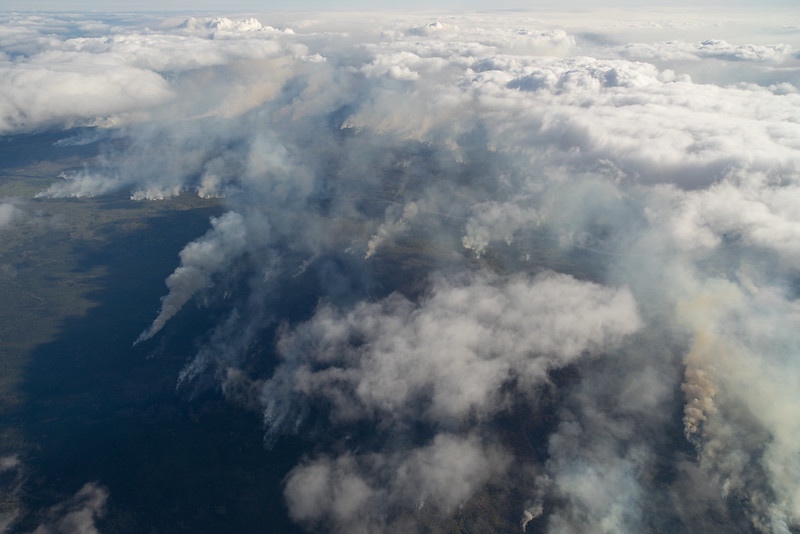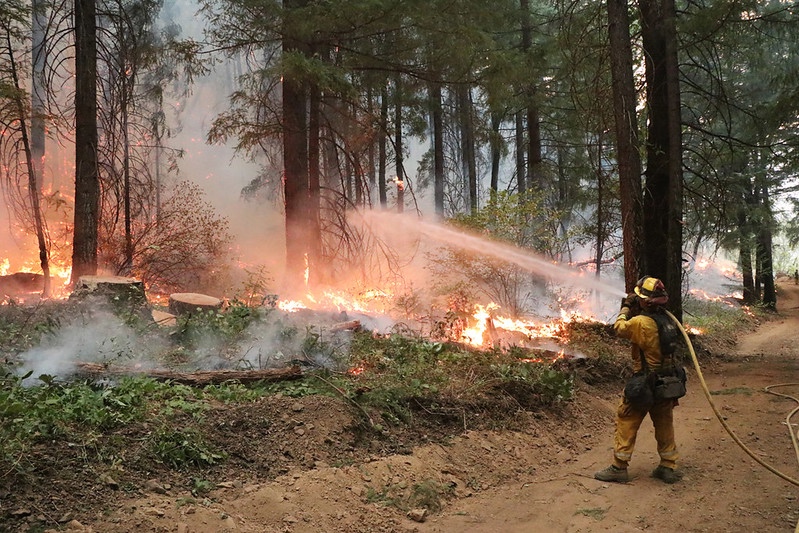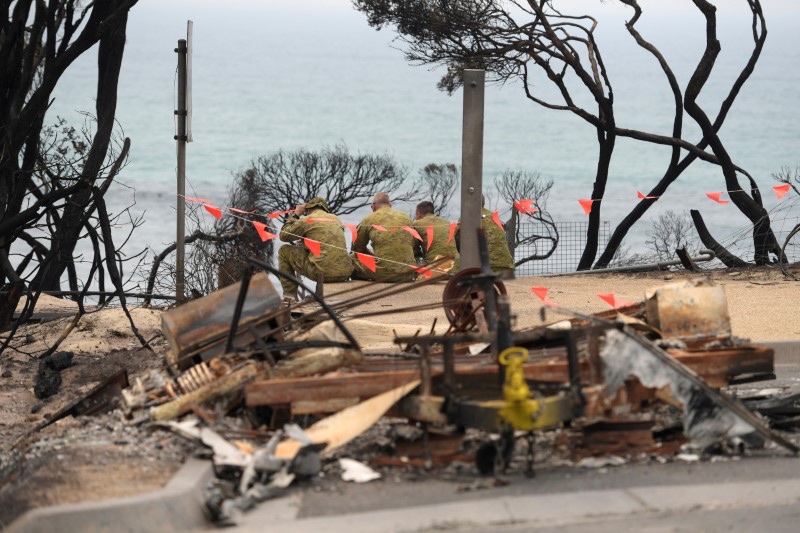
LAURIE GOERING, of Thomson Reuters Foundation, reports on how insurance companies are looking to the future in the face of rising economic costs from disasters…
Paris, France
Thomson Reuters Foundation
When forest fires swept into the Canadian city of Fort McMurray four years ago, a hurried evacuation of more than 80,000 people and the loss of thousands of homes and other buildings made the $US10-billion disaster the costliest in Canada’s history.
But when stunned residents set out to rebuild the northern Alberta city, insurers tried to make sure the huge losses – $US6 billion of which were uninsured – would not happen again.

Fires in Fort McMurray in May, 2016. PICTURE: Bo Lu/Flickr (licensed under CC BY-NC-ND 2.0)
Most allowed clients whose homes were destroyed to take a cash settlement and rebuild in a safer place instead of replacing fire-vulnerable homes near forests around the city.
More than a quarter of families took up that offer, said Tara Laidman, associate vice president at The Co-operators, a Canadian insurance firm providing policies in the city.
“Fort McMurray is now a much more resilient community, built back better.”
– Tara Laidman, associate vice president at The Co-operators, a Canadian insurance firm providing policies in Fort McMurray.
Other families, using replacement-cost policies, rebuilt with fire-resistant roofs, fewer wooden decks and other changes designed to cut fire risk, insurers said.
“Fort McMurray is now a much more resilient community, built back better,” said Laidman at an Organisation for Economic Co-operation and Development meeting in Paris last month that discussed how to tame wildfire threats.
As climate change brings hotter and drier conditions, and countries from Australia to Canada and Portugal to the United States struggle with worsening fires, all are looking for ways to curb surging risks and losses.
Insurance is expected to play an important role, both by compensating losses and by driving changes in building codes, warning systems and government policy which could cut risk.
But questions remain about the limits of insurance in tackling fast-rising threats – not only how people at highest risk and with lower incomes can afford it, but whether insurance models can cope with much more frequent and destructive fires.
“If your house is rebuilt twice in a century, on average, that’s going to be intolerable for the functioning of insurance,” warned Robert Muir-Wood, chief research officer of Risk Management Solutions, a firm that models catastrophe risk.
California, long accustomed to wildfires, has begun to experience those limits after a brutal 2018 fire year when 85 people – and thousands of homes – perished in blazes, including one that incinerated the town of Paradise.
Following the disaster – and massive losses – insurers began cancelling policies for homes featuring on new fire risk maps, even if their owners had paid premiums for decades and never made a claim, said California’s insurance commissioner Ricardo Lara.
Once dropped, “you can’t sell your home, it devalues your home and there’s less [tax] money for local government to provide services”, Lara told the OECD meeting.
Some families, he noted, were forced to buy the costliest insurance policies – sometimes paying more than for mortgages – while the poor could not afford cover at all.
California responded by introducing temporary restrictions on companies scrapping policies for homeowners in and around fire-hit areas.
But, as the state looks to a future with more frequent and fiercer fires, it is still figuring out how to mandate policy provision while keeping prices reasonable and insurance firms in business, Lara said.

A fire in California, north of Redding, in September, 2018. PICTURE: Jim Bartlett Team Rubicon/BLM for USFS via Flickr (licensed under CC BY 2.0)
One model may be Britain’s Flood Re, a joint effort between the government and insurance firms that aims to make flood policies more affordable for those at higher risk.
The initiative, launched in 2016, subsidises the cost of flood insurance for those living in low-lying areas, often along the sea or waterways, through a levy on all home insurance policies sold.
With one in six properties in Britain judged at high risk of flooding, according to Flood Re, the effort provides much-needed affordable insurance cover, backers say.
But it also raises questions about the tolerance of policy holders for helping out those at risk, especially if climate change brings more extreme rainfall and rising seas.
The success of such subsidies likely will depend on strong efforts to keep losses in check, such as installing seawalls or requiring rebuilt homes to put electrical systems higher on walls to stop them being damaged, insurers said.
One model may be Britain’s Flood Re, a joint effort between the government and insurance firms that aims to make flood policies more affordable for those at higher risk.
The reality is “insurers are not going to write business that is unprofitable. It’s not their function,” Muir-Wood said.
That raises “a political question on how governments should intervene” as risks and potential losses rise, he said.
Wildfires are already bringing a heavier economic burden.
In 2018, the cost of fighting wildfires broke $US3 billion for the first time for the US Federal Government alone, according to the National Interagency Fire Center.
Australia’s government allocated $A2 billion for an “initial” recovery fund this month after record bushfires hit every state and blanketed many large cities in heavy smoke.
On top of the emergency response and reconstruction of homes and other infrastructure, losses come from declines in tourism, export and other earnings as farms and businesses are hit, higher healthcare costs and falling property tax income.
Globally, 70 per cent of losses from wildfires and other “natural catastrophes” remain uninsured, representing about $US200 billion in annual losses, insurers said.

Soldiers sit on a beach amongst burnt trees where people had taken shelter during a fire on New Year’s Eve in Mallacoota, Australia, on 10th January, 2020. PICTURE: Reuters/Tracey Nearmy
In the future, reducing those losses will be crucial.
Better building codes show some promise. In the 2018 California fires, about half of houses built since 2008 – when fire-safe building codes tightened – survived the blazes, compared to 18 per cent of houses built earlier, Muir-Wood said.
Australia now has similar national building codes to cut fire risk, and it is older homes that see the highest losses, said Richard Thornton, head of the country’s Bushfire and Natural Hazards Cooperative Research Centre.
Recognising that “flammable vegetation and people don’t mix” and restricting rebuilding in areas at severe fire risk also will be needed, said Iain Colin Prentice, director of the Leverhulme Centre for Wildfires, Environment and Society at Imperial College London.
“Land use planning has to consider the risks, and they’re not going to go away,” he said.
Rethinking insurance payouts may also help.
Laidman, of The Co-operators in Canada, said her company offers flood-threatened policy holders $C5,000 upfront to put in sandbags, an inflatable dyke or other ways to defend their home.
That can “significantly reduce the severity of a claim”, she said, making sense for both insurers and their clients.
In the case of wildfires, pre-emptive cash might pay for application of flame retardant or other protective measures, she said – though because fires are harder to predict and move faster such measures would likely be less effective.
Simply giving homeowners clearer information on fire risks – using simple online tools, or providing data at the time of house purchases – could also help cut losses, she added.
Michael Norton, director general of Canada’s Northern Forestry Centre, which operates under the natural resources ministry, said steps to trim fire losses would be crucial in coming years. “The pace at which the fire problem is growing in Canada is overwhelming all of our systems and, like many of you, we are scrambling to catch up,” he told the OECD conference.
“Our trajectory is absolutely for more fire, bigger fires, more severe fires and longer fire seasons.”





